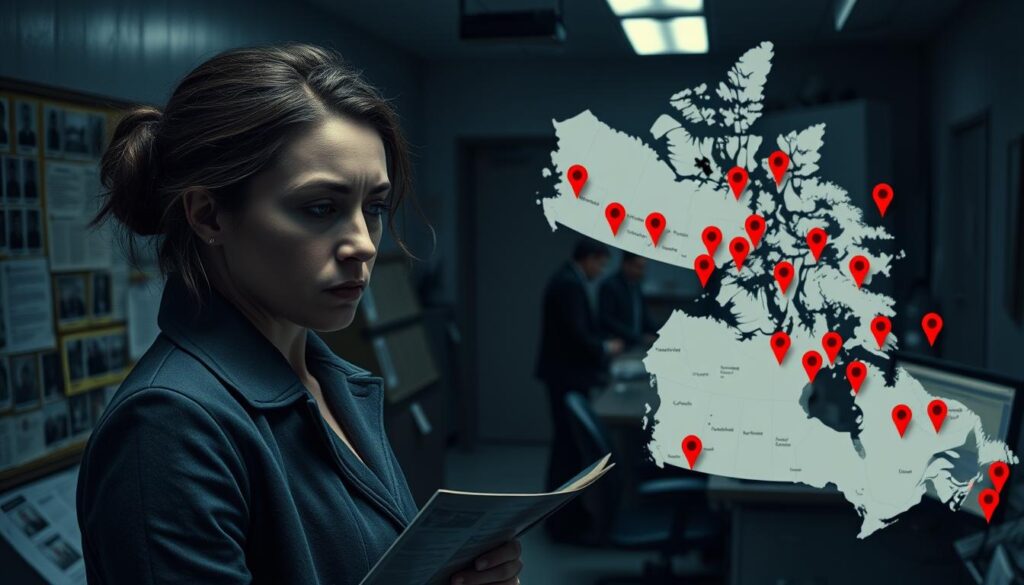Over 15 major legal reforms in Canada trace their origins to high-profile criminal cases that shocked the nation. These events didn’t just dominate headlines – they rewrote policies, reshaped police protocols, and altered how communities perceive safety.
You’ll explore how specific violent acts forced lawmakers to confront gaps in the justice system. From forensic evidence rules to victim protection laws, each case created ripple effects still felt today. The outcomes changed how people interact with legal institutions and transformed public expectations of accountability.
These crimes also tested societal values. Communities grappled with questions about mental health, systemic failures, and rehabilitation. Some investigations exposed flaws in how authorities handle missing persons reports or track dangerous offenders.
Through this analysis, you’ll see how tragedy became a catalyst for progress. The legacy lives on in tightened parole conditions, improved interagency cooperation, and victim-centric court processes. Understanding this history reveals why Canada’s approach to justice keeps evolving.
Introduction to Notorious Canadian Murders
Stricter firearm regulations and social programs create distinct crime dynamics compared to neighboring nations. While violent acts occur less frequently here than in the United States, their rarity amplifies their societal resonance. This contrast stems from differing policies – Canada’s gun control measures rank among the world’s tightest.

An Overview of Canada’s Crime Landscape
You’ll notice three key differences shaping criminal patterns here. First, firearm-related homicides occur at one-sixth the U.S. rate. Second, social safety nets reduce poverty-driven crimes. Third, concentrated urban populations mean high-profile cases quickly become national conversations.
These factors explain why singular events trigger widespread reforms. When violence breaks through Canada’s protective layers, it challenges assumptions about safety. Lawmakers often respond with preventative measures rather than reactive policies.
Understanding the Societal Impact
Major criminal investigations here don’t just solve cases – they rewrite rules. Victims’ stories spark debates about systemic gaps in marginalized communities. Public outcry over specific tragedies has reshaped everything from parole eligibility to missing persons protocols.
You’ll see how these events become cultural turning points. They force conversations about mental health support and offender rehabilitation. Each incident leaves fingerprints on policies that outlive media cycles.
High-Profile Cases That Shaped Canadian Law
Nation-changing precedents emerge when criminal trials reach the Supreme Court. These rulings don’t just resolve individual cases – they redefine how justice operates across provinces. You’ll find that decisions made here become blueprints for lower courts and permanently alter legal interpretations.
Landmark Legal Precedents
When defendants are found guilty in precedent-setting trials, the consequences ripple through time. One ruling might clarify evidence admissibility rules. Another could establish new standards for police enforcement conduct during investigations.
These judicial milestones often address systemic gaps exposed by high-stakes cases. For instance, certain verdicts have mandated better protections for witnesses. Others forced updates to how courts handle digital evidence – changes that now affect every trial nationwide.
You’ll notice how sentencing guidelines evolved through successive appeals. What began as isolated incidents became catalysts for standardized practices. Victim impact statements gained prominence because specific outcomes highlighted their importance in achieving balanced justice.
The Supreme Court’s role as final arbiter ensures its interpretations of laws become binding rules. This process transforms abstract legal principles into concrete safeguards. Each decision strengthens the framework protecting vulnerable groups while maintaining fairness for the accused.
Exploring Famous Canadian Murders
Violent acts spanning five decades reveal how investigative methods transformed alongside societal awareness. Early cases relied heavily on witness accounts, while modern detectives use digital footprints and DNA analysis. This evolution shows how justice systems adapt to new challenges in tracking dangerous offenders.

Historical Context and Modern Perspectives
You’ll notice a stark contrast between 1980s investigations and today’s protocols. Clifford Olson’s crimes exposed gaps in interprovincial communication, leading to standardized suspect databases. Recent arrests like Bruce McArthur’s demonstrate how facial recognition and data mining now prevent prolonged killing sprees.
Key Cases and Their Legacy
Elizabeth Wettlaufer’s healthcare facility crimes forced reforms in elder care oversight. Robert Pickton’s farm investigation sparked nationwide changes in missing persons protocols. “These tragedies became catalysts for systemic improvements,” observes a criminology expert from Simon Fraser University.
You’ll see how victim advocacy groups gained influence after high-profile trials. Improved trauma-informed interviewing techniques emerged from these dark chapters. Law enforcement training now emphasizes pattern recognition to identify potential serial killers earlier.
Case Study: Paul Bernardo and Karla Homolka
This disturbing spousal crime partnership reshaped public trust in legal proceedings through its unprecedented brutality. Between 1990 and 1992, the couple lured teenage girls to their Ontario home under false pretenses. Their actions exposed critical flaws in how prosecutors handle cooperating defendants.

Overview of the Case and Its Shocking Details
You’ll find the case details particularly harrowing. The couple recorded assaults on multiple victims, including Homolka’s younger sister. Evidence showed meticulous planning in kidnappings and disposal methods that delayed discovery.
Authorities initially treated Homolka as a coerced participant. Later revelations proved her active role, sparking debates about prosecutorial oversight. This discrepancy fueled lasting skepticism about plea negotiation transparency.
Charges, Trial, and Long-Term Impact on Justice
Bernardo was found guilty of first-degree murder in 1995, receiving a life sentence with no parole eligibility for 25 years. Homolka’s controversial deal – struck before full evidence emerged – gave her 12 years for manslaughter. Public fury over this disparity led to reforms requiring judicial review of all plea agreements.
| Aspect | Paul Bernardo | Karla Homolka |
|---|---|---|
| Charges | First-degree murder | Manslaughter |
| Prison Sentence | Life without parole | 12 years |
| Parole Eligibility | None | Released 2005 |
Today, this case influences how courts balance defendant cooperation against public interest. New rules prevent deals that downplay offender roles before all facts surface. Victims’ families now receive formal input during trial negotiations – a direct legacy of this national reckoning.
Case Study: The Robert Pickton Investigation
The disappearance of over 60 women from Vancouver’s Downtown Eastside exposed how societal biases cripple justice. Robert Pickton‘s targeting of sex workers revealed systemic indifference toward marginalized groups. His case forced British Columbia to confront flawed assumptions about who deserves protection.

The Investigation Process and Media Spotlight
You’ll find the search of Pickton’s Port Coquitlam pig farm took three years and yielded 500,000 DNA samples. Initial police dismissiveness toward missing persons reports allowed the killer to operate undetected. Families of victims repeatedly warned authorities about patterns of disappearances.
Implications for Law Enforcement and Policy Changes
This tragedy sparked Canada’s Missing Women Commission of Inquiry. New protocols now require immediate action on missing persons reports, regardless of the victim’s background. Interagency databases track cases across jurisdictions to spot serial patterns faster.
| Policy Area | Pre-Pickton | Post-Pickton |
|---|---|---|
| Missing Persons Response | 72-hour wait period | Immediate investigation |
| Victim Advocacy | Limited input | Mandatory family consultations |
| Data Sharing | Provincial silos | National database integration |
Media coverage shifted public perception of sex workers as disposable victims. “This case taught us that every life warrants equal investigative effort,” stated a Vancouver PD spokesperson. Ongoing reforms continue addressing historical gaps in protecting vulnerable populations.
The Role of Media and Public Response in Crime Cases
Public opinion often hinges on how news outlets frame criminal investigations. Media coverage plays a crucial role in determining what details become national obsessions – and which facts get overlooked. This dynamic creates powerful ripple effects in how people perceive justice and safety.

Media Influence on Public Perception
You’ll notice how sensational headlines can sway attitudes before trials begin. Outlets racing for clicks sometimes emphasize shocking details over context. This approach risks prejudicing potential jurors and skewing the public’s understanding of complex cases.
Balanced reporting faces challenges in high-stakes situations. A 2018 study found 63% of Canadians distrust crime coverage they perceive as exaggerated. Yet thorough journalism also drives positive change – like renewed search efforts for missing persons when stories gain traction.
Modern platforms amplify these effects. Social media lets users dissect evidence in real time, creating parallel narratives outside courtrooms. Viral posts sometimes pressure authorities to act faster, though not always accurately.
“Newsrooms walk a tightrope between public interest and ethical responsibility,” notes a Toronto media ethicist. “Every editorial choice shapes collective memory of these events.”
Documentaries and film adaptations extend this influence for decades. True-crime series reignite debates about closed cases, keeping victims’ stories alive while risking retraumatization. You’ll see how this lasting visibility impacts policy reforms and cultural attitudes alike.
Community Safety and Evolving Law Enforcement Strategies
Transformative shifts in public safety strategies emerged from lessons learned through pivotal criminal investigations. Law enforcement agencies now prioritize proactive measures over reactive responses, blending data analysis with grassroots engagement. This dual approach addresses systemic gaps while building trust in vulnerable neighborhoods.
Reforms in Policing and Legal Approaches
You’ll find modern police units now deploy specialized teams for cases involving marginalized groups. Mandatory trauma-informed training helps officers recognize signs of exploitation faster. Updated protocols require immediate follow-ups on missing persons reports – a direct response to past investigative delays.
Interagency databases now share real-time alerts across provinces. This enforcement upgrade prevents suspects from slipping through jurisdictional cracks. Budget increases fund advanced forensic tools, helping solve cold cases that once seemed impossible.
Community Outreach and Support Initiatives
Neighborhood watch programs now partner with social workers to address root problems. You’ll see outreach centers offering free legal help and counseling in high-risk areas. These hubs bridge gaps between communities and authorities, fostering collaborative crime prevention.
Victim advocacy groups receive 37% more funding than a decade ago. This supports crisis hotlines and safe housing for those fleeing dangerous situations. “We’ve shifted from punishment to protection,” explains a Toronto outreach coordinator. Society now recognizes that lasting safety requires addressing underlying needs like addiction and homelessness.
School-based initiatives teach youth conflict resolution, reducing future risks. These changes show how tragic events can spark solutions benefiting entire communities. The focus remains on creating systems where everyone feels seen – and protected.
Conclusion
These pivotal cases reshaped Canada’s approach to justice through hard-won lessons. You’ll find their fingerprints on modern police protocols, from faster missing persons responses to cross-province database sharing. Serial violence against sex workers and marginalized groups forced systemic accountability – no more dismissed reports based on bias.
Legal reforms now prioritize vulnerable communities, with stricter parole rules and trauma-informed investigations. Landmark trials set precedents for handling digital evidence and victim impact statements. While tragedies like Bruce McArthur’s targeting of gay men caused immense pain, they sparked crucial dialogues about institutional blindspots.
Today’s law enforcement strategies blend forensic advances with community outreach. Mandatory training helps officers recognize patterns that once went ignored. You’ll see lasting change in revised sentencing guidelines and victim advocacy programs – proof that even darkness can drive progress.
The legacy lives in quieter streets and fairer courtrooms. Through updated laws and preventative measures, these events remind us: justice evolves when society demands better protection for all.

